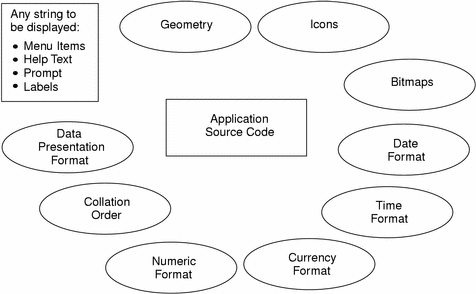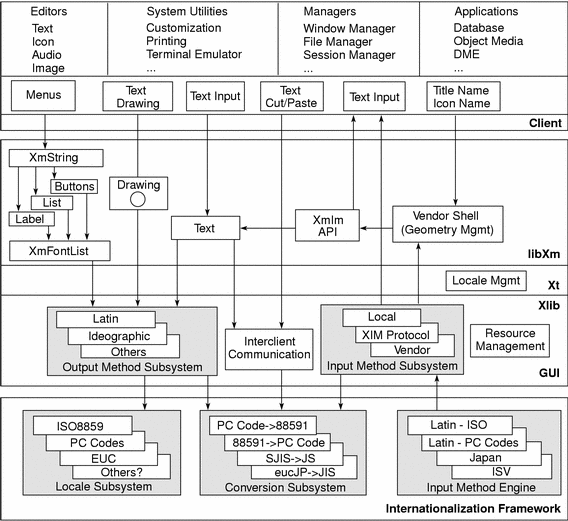Overview of Internationalization
Multiple environments may exist within a common open system for support of different national languages. Each of these national environments is called a locale, which considers the language, its characters, fonts, and the customs used to input and format data. The Common Desktop Environment is fully internationalized such that any application can run using any locale installed in the system.
A locale defines the behavior of a program at run time according to the language and cultural conventions of a user's geographical area. Throughout the system, locales affect the following:
-
Encoding and processing of text data
-
Identifying the language and encoding of resource files and their text values
-
Rendering and layout of text strings
-
Interchanging text that is used for interclient text communication
-
Selecting the input method (which code set will be generated) and the processing of text data
-
Encoding and decoding for interclient text communication
-
Bitmap/icon files
-
Actions and file types
-
User Interface Definition (UID) files
An internationalized application contains no code that is dependent on the user's locale, the characters needed to represent that locale, or any formats (such as date and currency) that the user expects to see and interact with. The desktop accomplishes this by separating language- and culture-dependent information from the application and saving it outside the application.
Figure 1-1 shows the kinds of information that should be external to an application to simplify internationalization.
Figure 1-1 Information external to the application

By keeping the language- and culture-dependent information separate from the application source code, the application does not need to be rewritten or recompiled to be marketed in different countries. Instead, the only requirement is for the external information to be localized to accommodate local language and customs.
An internationalized application is also adaptable to the requirements of different native languages, local customs, and character-string encodings. The process of adapting the operation to a particular native language, local custom, or string encoding is called localization. A goal of internationalization is to permit localization without program source modifications or recompilation.
For a quick overview of internationalization, refer to X/Open CAE Specification System Interface Definition, Issue 4, X/Open Company Ltd., 1992, ISBN: 1-872630-46-4.
Current State of Internationalization
Previously, the industry supplied many variants of internationalization from proprietary functions to the new set of standard functions published by X/Open. Also, there have been different levels of enabling, such as simple ASCII support, Latin/European support, Asian multibyte support, and Arabic/Hebrew bidirectional support.
The interfaces defined within the X/Open specification are capable of supporting a large set of languages and territories, including:
|
Script |
Description |
|---|---|
|
Latin Language |
Americas, Eastern/Western European |
|
Greek |
Greece |
|
Turkish |
Turkey |
|
East Asia |
Japanese, Korean, and Chinese |
|
Indic |
Thai |
|
Bidirectional |
Arabic and Hebrew |
Furthermore, the goal of the Common Desktop Environment is that localization of these technologies (translation of messages and documentation and other adaptation for local needs) be done in a consistent way, so that a supported user anywhere in the world will find the same common localized environment from vendor to vendor. End users and administrators can expect a consistent set of localization features that provide a complete application environment for support of global software.
Internationalization Standards
Through the work of many companies, the functionality of the internationalization application program interface has been standardized over time to include additional requirements and languages, particularly those of East Asia. This work has been centered primarily in the Portable Operating System Interface for Computer Environments (POSIX) and X/Open specifications. The original X/Open specification was published in the second edition of the X/Open Portability Guide (XPG2) and was based on the Native Language Support product released by Hewlett-Packard. The latest published X/Open internationalization standard is referred to as XPG4.
It is important that each layer within the desktop use the proper set of standards interfaces defined for internationalization to ensure end users get a consistent, localized interface. The definition of a locale and the common open set of locale-dependent functions are based on the following specifications:
-
X Window System, The Complete Reference to Xlib, Xprotocol, ICCCM, XLFD - X Version, Release 5, Digital Press, 1992, ISBN 1-55558-088-2.
-
ANSI/IEEE Standard Portable Operating System Interface for Computer Environments, IEEE.
-
OSFTM Motif 1.2 Programmer' Reference, Revision 1.2, Open Software Foundation, Prentice Hall, 1992, ISBN 0-13-643115-1.
-
X/Open CAE Specification Commands and Utilities, Issue 4, X/Open Company Ltd., 1992, ISBN 1-872630-48-0.
Within this environment, software developers can expect to develop worldwide applications that are portable, can interoperate across distributed systems (even from different vendors), and can meet the diverse language and cultural requirements of multinational users supported by the desktop standard locales.
Common Internationalization System
Figure 1-2 shows a view of how internationalization is pervasive across a specific single-host system. The goal is that the applications (clients) are built to be shipped worldwide for the set of locales supported in the underlying system. Using standard interfaces improves access to global markets and minimizes the amount of localization work needed by application developers. In addition, country representatives can be ensured of consistent localization within systems adhering to the principles of the desktop.
Figure 1-2 Common internationalized system

- © 2010, Oracle Corporation and/or its affiliates
